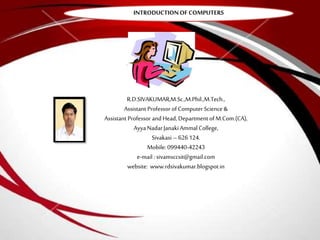
Introduction of Computers - R.D.Sivakumar
- 1. INTRODUCTIONOF COMPUTERS R.D.SIVAKUMAR,M.Sc.,M.Phil.,M.Tech., Assistant Professor of Computer Science & Assistant Professor and Head, Department of M.Com.(CA), AyyaNadar Janaki AmmalCollege, Sivakasi – 626124. Mobile: 099440-42243 e-mail : sivamsccsit@gmail.com website: www.rdsivakumar.blogspot.in
- 2. AComputer is an automatic Electronic Machine. Aword “Computing”it means ‘an act of ‘Calculating’. AComputer is abletoperforming basic operation like Addition, subtraction, multiplication, division. AComputer is alsoCapable of Storinginformation, which can be used later. Computers areVery accurate andSavetime by performing the operation very fast. HISTORY OF COMPUTERS
- 3. EARLY HISTORYOF COMPUTER 2500 BC The Abacus 1614 AD Napier’s Bones 1633 AD The Slide Rule 1890 AD Hollerith Tabulating Machine 1642 AD The Rotating wheel Calculator 1822 AD The Difference Engine
- 4. 2500BC – THE ABACUS Abacus is the first Known Calculating machine used for counting. It is made of beads strung on cords. It is used for simple arithmetic calculations like addition, subtraction, multiplication, division. The cords Correspond to positions of Decimal digits, the beads represent digits. Numbers are represented by beads close to the crossbar.
- 5. 1614AD – NAPIER’SBONES The Napier’s Bones was invented by John Napier, a Scottish Mathematician. Napier’s Bones is used for multiplication. A set of bones consisted of nine rods, one for each digit 1 through 9 , and a constant Rod for the digit ‘0’. A rod is Similar to one column of a multiplication table. John Napier
- 6. 1633AD – THE SLIDERULE The Slide Rule was invented by William Oughtered. The Slide Rule is also known as “SlipStick”. The Slide Rule is primarily used for multiplication and division and also used for function as roots, Logrithms, trignomenry. It is made up of two sets of scales that are joined together. The suitable align of two scales enabled the slide rule to perform multiplication and division. William Oughtred THE SLIDE RULE
- 7. 1642AD – THE ROTATINGWHEEL CALCULATOR The Rotating Wheel Calculator was invented by French Philosopher, Blaise Pascal. This is a Predecessor to today’s electronic calculator. It is using simple components such as gears and levers. THE Rotating Wheel Calculator
- 8. 1822AD – THE DIFFERENCE ENGINE The Difference Engine was built by Charles Babbage, the father of today’s Computer. The Difference Engine is a automatic Mechanical calculator. It is designed to tabulate polynomial function. Polynomial involves variables and co-efficients. It operates the functions are addition, subtraction, multiplication and non negative integer exponents. TheDifference Engine Charles Babbage
- 9. 1890AD – HOLLERITH TABULATING MACHINE A tabulating machine was designed by Herman Hollerith. The Hollerith Tabulating Machine is able to read the information on the punched cards . The Punched card as the basis for storing and processing the information electronically. Hollerith Tabulating Machine Herman Hollerith
- 10. GENERATION OF COMPUTERS First Generation Second Generation Fourth Generation Third Generation Fifth Generation Vacuum Tubes (1940 – 1956) Transistors (1956 – 1963) Integrated Circuits (1964 – 1971) Microprocessors (1971 - Present) Artificial Intelligence (Present - Beyond)
- 11. FIRST GENERATION– 1940-1956:VACUUM TUBES The 1st generation of computers used Vacuum tubes for circuitry and magnetic drums for memory. The Vacuum or electron tube is a device that controls the electric current through a Vacuum in a sealed container . The Vacuum tubes are large in size, occupied a lot of space and produced enormous heat. The Input was based on punched cards and paper tape. The Output was displayed on printouts. EXAMPLE The Universal Automatic Computer (UNIVAC). The Electronic Numerical Integrator And Calculator (ENIAC). Vacuum Tubes UNIVAC ENIAC
- 12. SECONDGENERATION– 1956– 1963:TRANSISTORS The Transistor was superior to the vacuum tube . The Transistor regulates the current or voltage flow and act as a switch for electronic signals. The Transistor is allowing computers to become smaller, faster, cheaper, energy efficient More reliable. The Transistor had 3 legs are (Base, Collector, Emitter). Base – Activating the Transistor. Collector – Positive Lead. Emitter – Negative Lead. Transistor ENIAC
- 13. THIRD GENERATION –1964 -1971 : INTEGRATED CIRCUITS An Integrated Circuits or chip is a electronic circuits on one smaller plate of semi conductor material normally a silicon. It is small in size and High speed and efficiency of computers. Integrated circuits ENIAC
- 14. FOURTHGENERATION– 1971: MICROPROCESSORS The Microprocessors is a silicon chip contains a computer processing unit(CPU). The Microprocessors executes the set of instructions. Microprocessors ENIAC
- 15. FIFTHGENERATION-Present& Beyond– ARTIFICIALINTELLIGENCE Artificial Intelligence is the human-like intelligence exhibited by machines or software. It is bridging the gap between computing and thinking. Artificial Intelligence ENIAC
